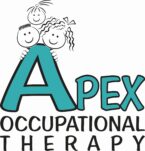With the start of the school year I thought that this would be a helpful post to start off my blog. In addition to running my groups and seeing clients here at Apex Occupational Therapy, I work in area schools, both district and charter, and I know how things work. Well, how they are supposed to work. Here are some tips to help you support your child in the special education process (called “EC” for Exceptional Children here in North Carolina).
Some of you may hear from your child’s teacher that she is having some difficulty keeping up with the class. Naturally you don’t want to hear this about your child, but it is important to remember that every child learns differently and not all learning styles are fostered in a typical classroom (a topic for another post). Be thankful that you have a team of people at the school ready to help your child be successful!
Hearing this news and understanding the special education process can be overwhelming for parents. Teachers are often not well trained to explain the process, and the use of acronyms and jargon just adds to the confusion. Here are some things that are important to know or to keep in mind if you’ve already been through this process.
1. Special education isn’t what it used to be.
It does not have the stigma it did in the past. Some children only have it a short time; it isn’t necessarily forever. It does not mean a special bus or special classroom for the majority of the children who receive special education services.
2. IEP stands for Individualized Education Program.
This is a legal document that clarifies how special education services are provided. Your child cannot receive special education without it. Any changes require a meeting with the IEP team (see #3).
3. It’s a team effort
An Individualized Education Program (IEP) is a team-made document. The team includes you, the classroom teacher, special education teacher, school representative, and any other specialists working with your child.
In the interest of time teachers often create a draft IEP prior to the meeting, but input should be from all team members. That includes you, mom and dad. Don’t be afraid to ask for a draft of the document before the meeting so you can review it.
4. You have the right to ask questions and provide input.
Educators are supposed to make a jargon-free document, but that doesn’t mean that they do. Teachers are often poorly trained in how to write IEPs and how to run IEP meetings. They aren’t necessarily thinking that you have no idea what “rubric” or “pre-primer” mean. Don’t be afraid to ask. This is your kid we’re talking about.
5. A child must require specially designed instruction to have an IEP.
What does that mean? It means they have delays or a disability that keeps them from learning in the classroom with differentiated instruction (teaching to different levels and learning styles). They need material taught at a different pace and/or with different strategies.
6. Children should be with typically developing peers when possible.
IDEA (Individuals with Disabilities Education Act), the legislation that mandates a free and appropriate public education to all children, requires that children are in the least restrictive environment (LRE). This means that a child should not be separated from peers unless it is absolutely necessary to help them learn. Special education teachers should provide service in the classroom if possible. Being in the classroom harnesses the power of the peer model–children often do their best when they have peers as role models.
7. Related services (PT, OT, ST) need to be educationally relevant.
Occupational therapy, physical therapy, and speech therapy are considered related services, which means they need to relate to educational participation. School is not a therapy clinic. If it’s not part of the curriculum and not part of peer interactions or accessing the environment then therapy at school may not be appropriate. The goal for therapy at school is to level the playing field, and often adaptations can do that. For instance, a child who fatigues easily when writing can be given a modification in his IEP to have access to a computer so he can type. Direct therapy would not be indicated if there is a modification that can help him be functional. Also, if a teacher has the skills to address an issue then you may not need a therapist to do that as well.
Look for upcoming blog posts about each of these areas and about 504 Plans, another way for some children to get additional help in school. I would love to hear from parents–what have been your experiences? Have a great school year!
Oh, one more thing—your child’s school should have offered you a Parents Rights Handbook if your child is in the process of being tested or is receiving an IEP. Make sure you read this so you know your rights. Here is a link to the one in North Carolina Parents Rights Handbook in English. There is also a Spanish version.
Need an advocate or second opinion? I can help!

